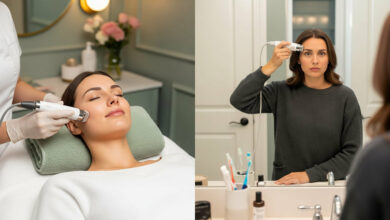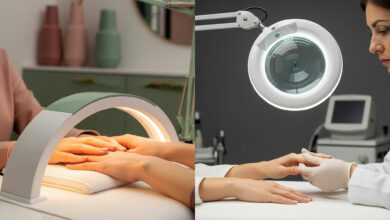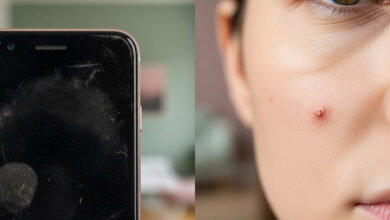Acne Scars & Marks
After a breakout clears, it can often leave a lingering reminder, but it’s crucial to distinguish between a temporary “mark” and a true “scar.” Marks, known as post-inflammatory hyperpigmentation (PIH), are flat spots of red, purple, or brown discoloration. Scars, however, are textural changes—either depressions in the skin (atrophic) or raised tissue (hypertrophic)—resulting from damage to the skin’s deeper layers.
These two concerns form in different ways. Discolored marks are the direct result of the skin’s inflammatory response to the initial pimple, which triggers an overproduction of pigment. True textural scars occur when deep inflammation from a blemish damages the surrounding collagen; the skin then produces either too little or too much collagen during the healing process, creating a permanent change in texture.
The strategy for treatment depends entirely on whether you have a mark or a scar. Pigmented marks can be effectively faded over time with consistent use of ingredients like retinoids, Vitamin C, and niacinamide, plus daily sunscreen to prevent darkening. While topical treatments can soften the appearance of scars, significant textural improvement often requires professional procedures. At sylvaia, we help you identify your specific concern and guide you toward the most effective solutions for a smoother, more even complexion.
-
Adult Acne
Microneedling vs. Fractional Laser: A Comparison for Treating Old Acne Scars
Table of contentsBeyond the Breakout: The Battle with Post-Acne ScarsThe Science of Scar Repair: The Goal is Collagen RemodelingContender #1: Microneedling (The “Collagen Stimulator”)How It WorksPros & ConsBest For:Contender #2: Fractional Laser (The “Targeted Resurfacer”)How It WorksPros & ConsBest For:The Most Important Step: Which is…
-
Flawless Base
Ranking the Best Color Correcting Palettes for Neutralizing Redness and Dark Spots
Table of contentsThe Pro Secret to a Truly Flawless Base (Without the Heaviness)The 60-Second Color Theory Lesson You Need to KnowThe Sylvaia Ranking: Our Top 3 Color Correcting Palettes#1 The Beginner’s Perfect Playground: NYX Professional Makeup Color Correcting Concealer Palette#2 The Luxury All-in-One System: Stila…
-
Anti-Aging Care
Fractional Laser vs. HIFU: Which Is Better for Skin Tightening on the Face?
Table of contentsThe Modern Quest for Firmness: Beyond Creams and SerumsThe Contender #1: Fractional Laser (The “Skin Resurfacer”)The Science: How It WorksThe Verdict: Fractional Laser is Best For…The Contender #2: HIFU (The “Deep Structural Lifter”)The Science: How It WorksThe Verdict: HIFU is Best For…The At-a-Glance…
-
Hand & Nail Health
Are the UV Lamps for Gel Polish Dangerous? A Scientific Review
Table of contentsThe “Price” of a Perfect Manicure: Unpacking the UV RiskThe Science: Understanding the Radiation in Your Nail LampIt’s All About UVA RaysThe Role of UVA in Skin AgingThe Verdict: Assessing the Actual Level of RiskThe Scientific Consensus: The Risk is Low, But Not…
-
Hormonal Skin
Ranking the Best Vitamin C Serums for Brightening Post-Acne Hormonal Marks
Table of contentsThe Frustrating Aftermath of a Hormonal BreakoutThe Science: How Vitamin C Fades PigmentationIt Stops Pigment Production at the SourceIt Protects Against Further DarkeningOur Ranking Criteria: What to Look For in a Potent FormulaThe Sylvaia Ranking: Our Top 3 Serums for Fading Marks#1 The…
-
Adult Acne
Retinol or Azelaic Acid for Acne
Table of contentsThe Battle of the Powerhouse Acne IngredientsMeet the ContendersRetinol: The Gold-Standard RenewerAzelaic Acid: The Gentle Multi-TaskerHead-to-Head: A Point-by-Point ComparisonFor Clogged Pores, Blackheads & WhiteheadsFor Red, Angry, Inflamed PimplesFor Fading Post-Acne MarksFor Sensitive or Reactive SkinFor Added Anti-Aging BenefitsThe Verdict: How to Choose (and…
-
Adult Acne
We Challenged Experts: The Best Acne Treatment
Table of contentsThe Overwhelming Search for a SolutionWhy Experts Agree on Retinoids for Adult AcneThey Don’t Just Treat Pimples; They Prevent Them at the SourceThey Are the Ultimate Multi-Taskers for Adult SkinYour Practical Guide to Starting with RetinoidsUnderstanding the Retinoid FamilyThe Golden Rules of Application…
-
Body Confidence
The 3 Myths Society Has Imposed on Us About Women’s Bodies
Table of contentsThe Invisible Stories We Were Taught to BelieveMyth #1: The Myth of a “Flawless” BodyThe Myth DefinedThe Truth: Your Body Is a Biography, Not a Blank CanvasMyth #2: The Myth of a “Constant” BodyThe Myth DefinedThe Truth: Your Body Is a Dynamic and…
-
Body Confidence
What’s a Unique Feature of Your Body That You’re Proud of?
Table of contentsThe Question We Don’t Ask Ourselves EnoughRedefining Beauty: From Standardized to SingularThe Stories Etched on Our SkinThe Power in Our FormThe “Quirks” That Define UsInspiration from Our CommunityMeet Sarah, and the Freckle She Used to HideMeet Elena, and Her Strong HandsMeet Chloe, and…
-
Body Confidence
A Letter to My Younger Body and the Things I Wish I had Known
Table of contentsTo the Girl I Treated Like a BattlegroundLesson One: Your Worth Was Never an Equation to Be SolvedLesson Two: Your “Flaws” Were Chapters in Your StoryLesson Three: Rest Is Not Weakness; It Is Your SuperpowerLesson Four: You Were Speaking to Me All AlongWith…
-
Natural Makeup
The Power of Confidence That Lies in Showing Your Real Skin
Table of contentsThe Beautiful Armor We Learn to WearThe Moment the Armor CracksRedefining Power: From a Flawless Face to an Authentic OneThe Magnetism of AuthenticityThe Freedom of Releasing PerfectionWhere “Invisible Makeup” Fits InYour First Steps Toward Skin ConfidenceStart with Care, Not CoveragePractice “Strategic Concealing,” Not…




















